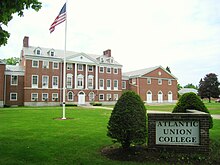Atlantic Union College
 |
|
| Motto | Fiat Lux (Let There Be Light) |
|---|---|
| Type | Private |
| Established | 1882 as a preparatory school, 1922 as a degree-granting college |
| Affiliation | Seventh-day Adventist Church |
| President | Dr. Avis D. Hendrickson |
| Location |
South Lancaster, Massachusetts, US 42°26′42.26″N 71°41′9.41″W / 42.4450722°N 71.6859472°WCoordinates: 42°26′42.26″N 71°41′9.41″W / 42.4450722°N 71.6859472°W |
| Campus | Rural |
| Affiliations | COWC |
| Website | www.auc.edu |
Atlantic Union College (AUC) is a Seventh-day Adventist college in South Lancaster, Massachusetts, founded in 1882.
As of 2017, the college offers two bachelor's degree programs, the BA in Theology/Religion and the BS in Biology/Health Science, as well as several certificate programs.
From 1933 to 2011 AUC was a four-year liberal arts college with a peak enrollment of over 700 students. After a financial crisis in 2011 it suspended bachelor's degree programs, and resumed them on a smaller scale in 2015.
Founded in 1882, Atlantic Union College in South Lancaster, Mass. is the oldest campus in the Seventh-day Adventist worldwide educational system. In 1882, the school was organized as a preparatory school under the leadership of Adventist 'pioneer' Stephen Nelson Haskell to serve the needs of Adventist constituents in the northeastern part of the United States and Bermuda, and was named "That New England School". The next year, it was incorporated and renamed South Lancaster Academy. In 1918, it was renamed: Lancaster Junior College. Then, in 1922, it was yet again renamed Atlantic Union College after being authorized to grant degrees in the state of Massachusetts. That year, the academy and college separated. In 1933, Governor Joseph Ely granted AUC the right to confer the bachelor of arts degree. In 1945, the school was first accredited by the New England Association of Schools and Colleges (NEASC). In 1954, it was authorized to grant the bachelor of science degree. Herbert E. Douglass was president from 1967 to 1970. In 1990, Atlantic Union College was authorized to grant the master of education degree.l
In 1993, with 82% of enrolled students receiving financial aid, there was a high default rate on student loans and enrollment was dropping well below projections. An auditor's report had shown the college was "essentially bankrupt" and at the time was at least $3 million in debt. By the Fall of 1994, another enrollment drop forced them to borrow $2 million to get through the 94-95 school year; a violation of North American Division working policy to borrow money for operating purposes. In May 1995, the AUC had $6.2 million in debt. Approximately $3 million was owed to the Atlantic Union Revolving Fund and $2.4 million owed to the General Conference. By August 1995, AUC met their first cash crunch and were forced to dip into the endowment funds to meet payroll. This process was repeated in November and December of the same year until the endowment funds were exhausted.
...
Wikipedia
